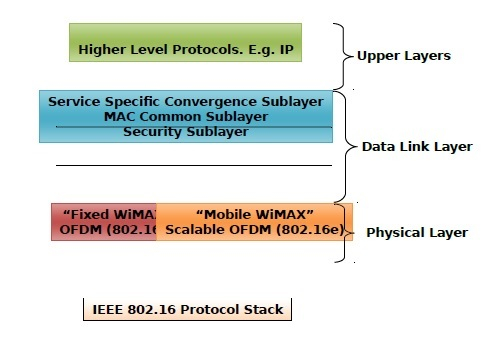
 Data Structure
Data Structure Networking
Networking RDBMS
RDBMS Operating System
Operating System Java
Java MS Excel
MS Excel iOS
iOS HTML
HTML CSS
CSS Android
Android Python
Python C Programming
C Programming C++
C++ C#
C# MongoDB
MongoDB MySQL
MySQL Javascript
Javascript PHP
PHP
- Selected Reading
- UPSC IAS Exams Notes
- Developer's Best Practices
- Questions and Answers
- Effective Resume Writing
- HR Interview Questions
- Computer Glossary
- Who is Who
The 802.16 Protocol Stack
The IEEE 802.16 set of standards lays down the specifications for wireless broadband technology. It has been commercialized as Worldwide Interoperability for Microwave Access (WiMAX) and is responsible for delivery of last mile wireless broadband access.
The IEEE 802.16 lays down the standards for both physical layer as well as medium access control (MAC) layer for WiMAX. The general structure of the IEEE protocol stack is shown as below −

As shown in the diagram, IEEE 802.16 lays down the standards for physical layer and data link layer.
- Physical Layer − The two popular services of the physical layer are fixed WiMAX and mobile WiMAX. They operate in the licensed spectrum below 11 GHz. Fixed WiMAX was released in 2003 and uses OFDM; while mobile WiMAX was released in 2005 and uses scalable OFDM.
-
Data Link Layer − The data link layer is subdivided into three sublayers −
- Security sublayer − This is the bottommost layer and is concerned with security and privacy of the wireless network. It deals with encryption, decryption and key management.
- MAC common sublayer − The MAC sublayer is concerned with channel management. The channel management is connection oriented, a feature that plays due to which quality of service (QoS) guarantees are given to the subscriber. The base station controls the system. It schedules the channels from base station to the subscriber (downlink channels) and also manages the channels from the subscriber to the base station (uplink channels).
- Service specific convergence sublayer − This is equivalent to logical link control layer of other systems. It provides the required services and interface to network layer.

Advertisements
